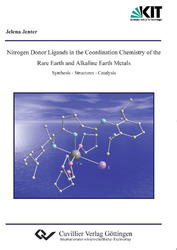| Fachbereiche | |
|---|---|
| Buchreihen (96) |
1378
|
| Nachhaltigkeit |
3
|
| Gesundheitswesen |
1
|
| Geisteswissenschaften |
2364
|
| Naturwissenschaften |
5406
|
| Mathematik | 229 |
| Informatik | 319 |
| Physik | 980 |
| Chemie | 1363 |
| Geowissenschaften | 131 |
| Humanmedizin | 243 |
| Zahn-, Mund- und Kieferheilkunde | 10 |
| Veterinärmedizin | 108 |
| Pharmazie | 147 |
| Biologie | 835 |
| Biochemie, Molekularbiologie, Gentechnologie | 121 |
| Biophysik | 25 |
| Ernährungs- und Haushaltswissenschaften | 45 |
| Land- und Agrarwissenschaften | 1004 |
| Forstwissenschaften | 201 |
| Gartenbauwissenschaft | 20 |
| Umweltforschung, Ökologie und Landespflege | 148 |
| Ingenieurwissenschaften |
1793
|
| Allgemein |
98
|
|
Leitlinien Unfallchirurgie
5. Auflage bestellen |
|
Erweiterte Suche
Nitrogen Donor Ligands in the Coordination Chemistry of the Rare Earth and Alkaline Earth Metals
Synthesis - Structures - Catalysis
Jelena Jenter (Autor)Vorschau
Inhaltsverzeichnis, Datei (59 KB)
Leseprobe, Datei (70 KB)
Bis(phosphinimino)methanide rare earth metal bisborohydrides, as illustrated in Scheme I, were successfully synthesized by salt metathesis reactions of [K{CH(PPh2NSiMe3)2}] with [Ln(BH4)3(THF)n] (Ln = Sc (n = 2); Ln = La, Nd, Lu (n = 3)) or in the case of yttrium by the reaction of [{(Me3SiNPPh2)2CH}YCl2]2 with NaBH4. Interestingly, the BH4- anions are
?3-coordinated in the solid state structures of 3, 4, 6 and 7, while for the scandium complex 5 two different conformational polymorphs were identified, in which either both BH4- groups are ?3-coordinated or one BH4- anion shows an ?2-coordination mode. Furthermore, complexes 3, 6 and 7 showed high activities in the ring-opening polymerization (ROP) of
e-caprolactone (CL). At 0 °C, the molar mass distribution reached the narrowest values ever obtained for the ROP of CL initiated by a rare earth metal borohydride species.
In collaboration with N. Meyer, rare earth metal chlorides and borohydrides of the
2,5-bis{N-(2,6-diisopropylphenyl)iminomethyl}pyrrolyl ligand were synthesized, as shown in Scheme II. The reaction of [(DIP2pyr)K] (10) with anhydrous neodymium trichloride afforded [(DIP2pyr)NdCl2(THF)]2 (12) which is dimeric in the solid state. Excitingly, the reaction of [(DIP2pyr)K] (10) with [Ln(BH4)3(THF)n] (Ln = Sc (n = 2); Ln = La, Nd, Lu (n = 3)) depends on the ionic radii of the center metals. For the larger rare earth metals lanthanum and neodymium, the expected products [(DIP2pyr)Ln(BH4)2(THF)2] (Ln = La (13), Nd (14)) were obtained; while for the smaller rare earth metals scandium and lutetium, an unusual redox reaction of a BH4- anion with one of the Schiff-base functions of the ligand was observed and the products [{DIP2pyr*-BH3}Ln(BH4)(THF)2] (Ln = Sc (15), Lu (16)) were formed
(Scheme II). Moreover, the two neodymium containing complexes 12 and 14 were investigated as Ziegler-Natta catalysts for the polymerization of 1,3-butadiene to form
poly-cis-1,4-butadiene, by using various cocatalyst mixtures. Very high activities and good selectivities were observed for 12.
The 2,5-bis{N-(2,6-diisopropylphenyl)iminomethyl}pyrrolyl ligand was successfully introduced into the coordination chemistry of the divalent lanthanides and the alkaline earth metals. As shown in Scheme III, salt metathesis reactions of [(DIP2pyr)K] (10) with either anhydrous lanthanide diiodides or alkaline earth metal diiodides afforded the corresponding heteroleptic iodo complexes [(DIP2pyr)LnI(THF)3] (Ln = Sm (19), Eu (20), Yb (21)) or [(DIP2pyr)MIn] (M = Ca (24), Sr (22) (n = 3); Ba (23) (n = 4)). Surprisingly, all complexes 19-24 are monomeric in the solid state, independently from the ionic radii of their center metals. Instead of forming dimers, the coordination sphere of each metal center is satisfied by additionally coordinated THF molecules, which is a very rare structural motif in the chemistry of the larger divalent lanthanides and alkaline earth metals. While the (DIP2pyr)- ligands in 19-23 are ?3-coordinated in the solid state, for the calcium complex 24 an ?2-coordination mode was observed (Scheme III). Interestingly, the calcium complex 24 and the analogous ytterbium compound 21 show different structures in the solid state.
In order to obtain catalytically active species, [(DIP2pyr)M{N(SiMe3)2}(THF)2] (M = Ca (25), Sr (26)) were prepared by the reaction of [(DIP2pyr)MI3] (M = Ca (24), Sr (22)) with [K{N(SiMe3)2}] (Scheme IV). Compounds 25 and 26 were investigated for the intramolecular hydroamination of aminoalkenes and one aminoalkyne. Unfortunately, both catalysts exhibit a limited reaction scope, caused by the formation of undesired side products by alkene isomerization and imine-enamine tautomerism. However, both compounds are active catalysts and show high yields and short reaction times. The highest activities were observed for the calcium complex 25 and can be compared to the results obtained with the
ß-diketiminato calcium amide [{(DIPNC)2CH}Ca{N(SiMe3)2}(THF)] as a catalyst.
Finally, imidazolin-2-imide and cyclopentadienyl-imidazolin-2-imine rare earth metal alkyl complexes, synthesized by M. Tamm et al., were investigated for the intramolecular hydroamination of non-activated aminoalkenes and one aminoalkyne. Both compounds showed high selectivities and activities, and although they cannot compete with the metallocene analogues, the imidazolin-2-imide complexes are new and interesting examples for catalytically active post-metallocenes.
| ISBN-13 (Printausgabe) | 3869553421 |
| ISBN-13 (Printausgabe) | 9783869553429 |
| ISBN-13 (E-Book) | 9783736933422 |
| Sprache | Englisch |
| Seitenanzahl | 134 |
| Auflage | 1 Aufl. |
| Band | 0 |
| Erscheinungsort | Göttingen |
| Promotionsort | Universität Karlsruhe |
| Erscheinungsdatum | 27.05.2010 |
| Allgemeine Einordnung | Dissertation |
| Fachbereiche |
Chemie
|








